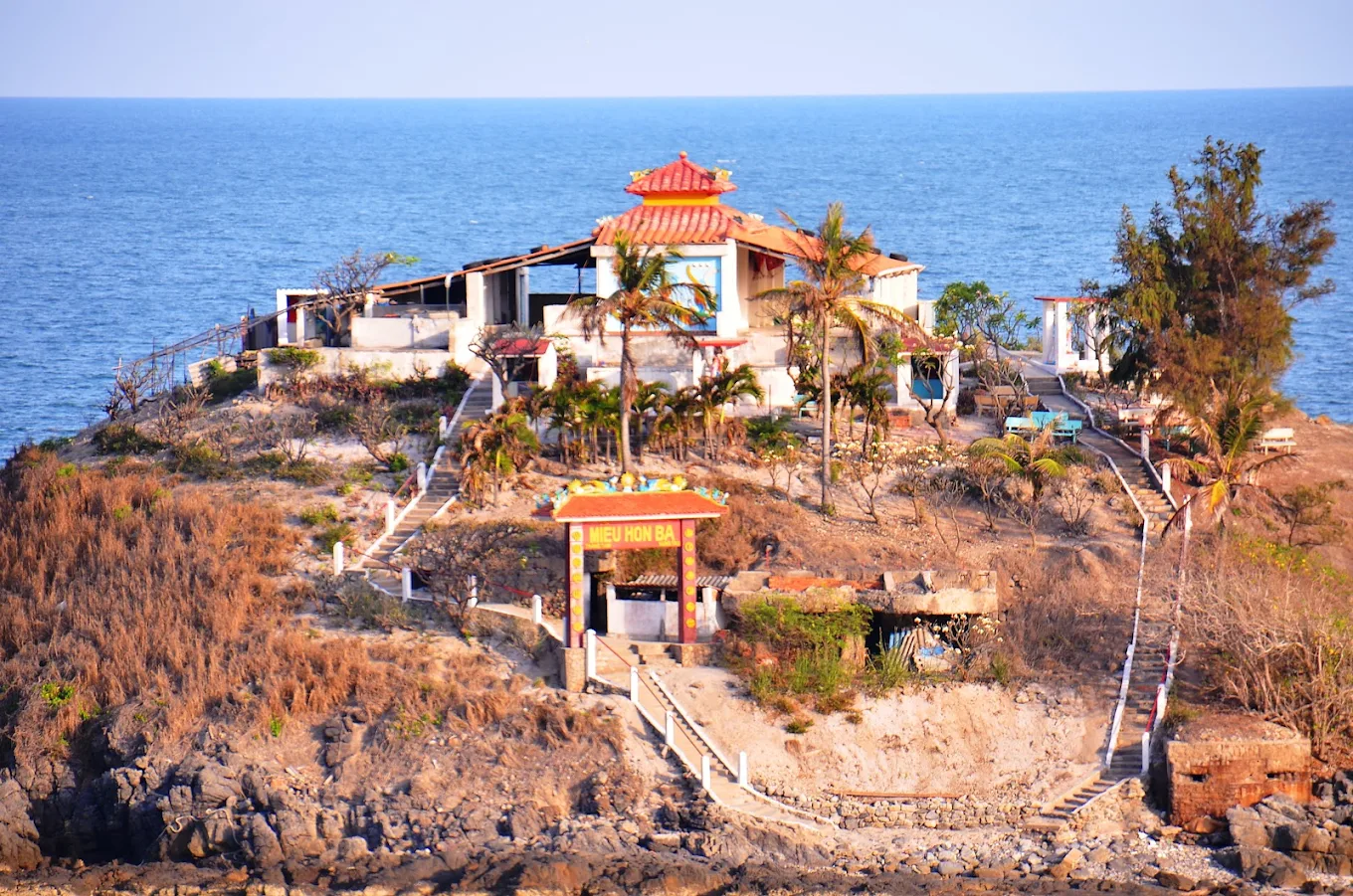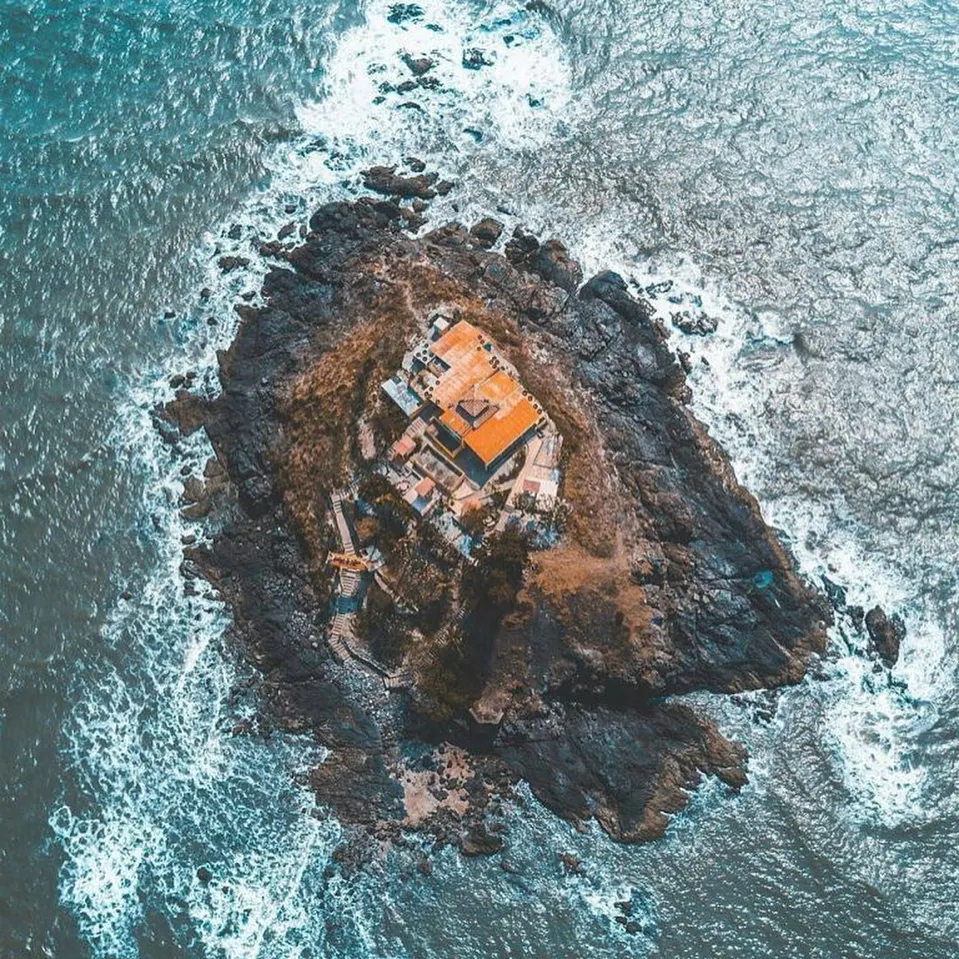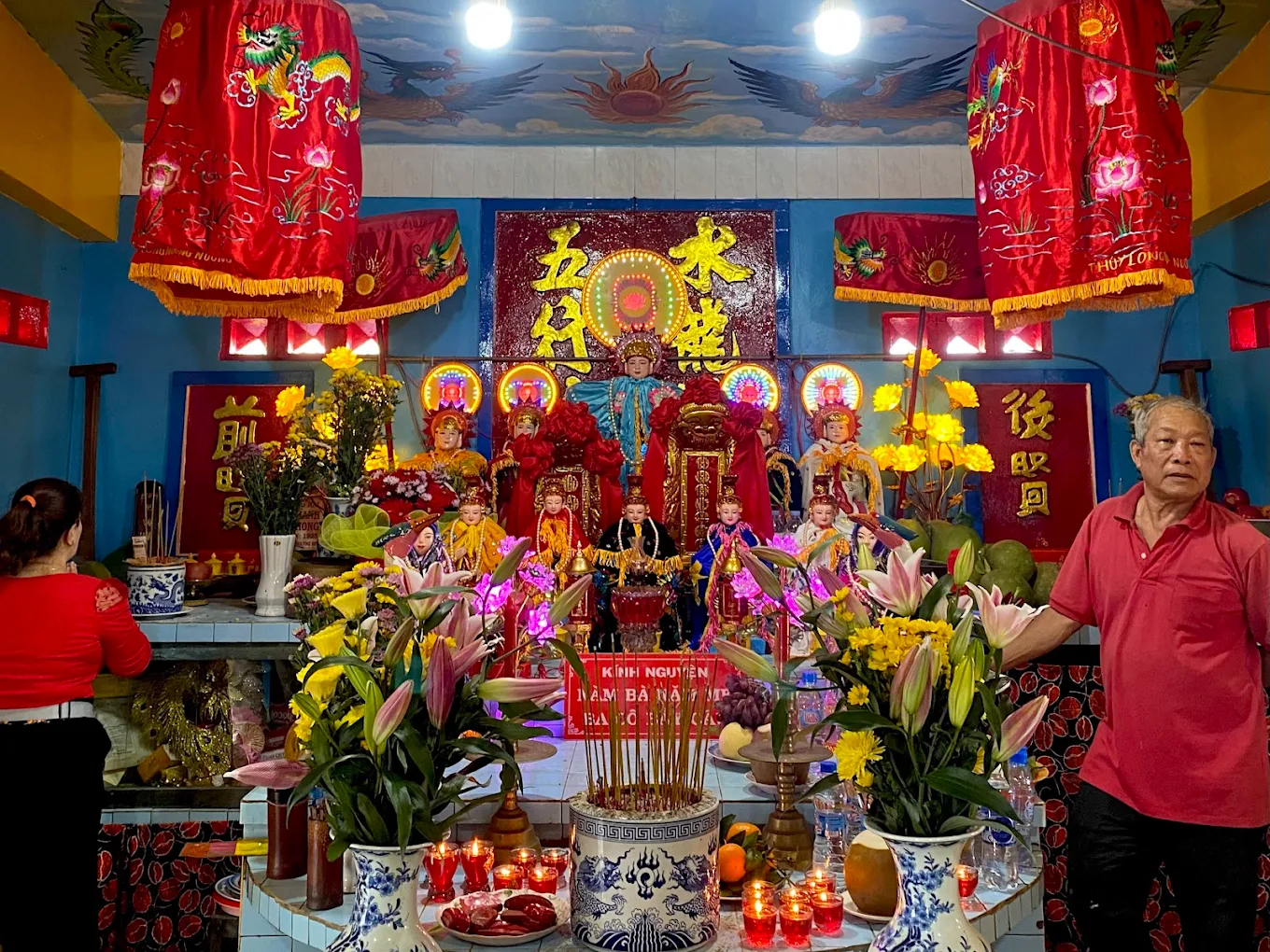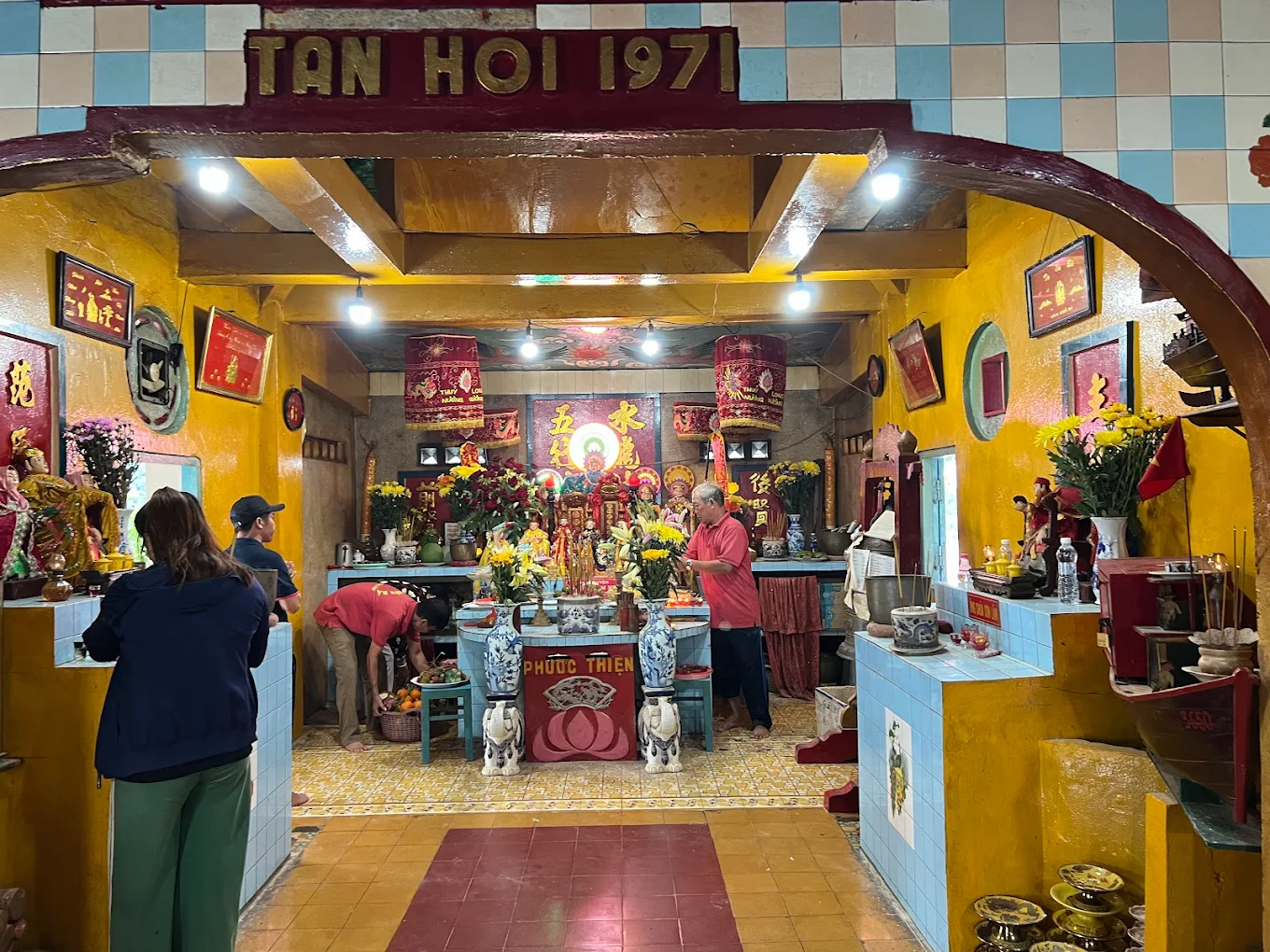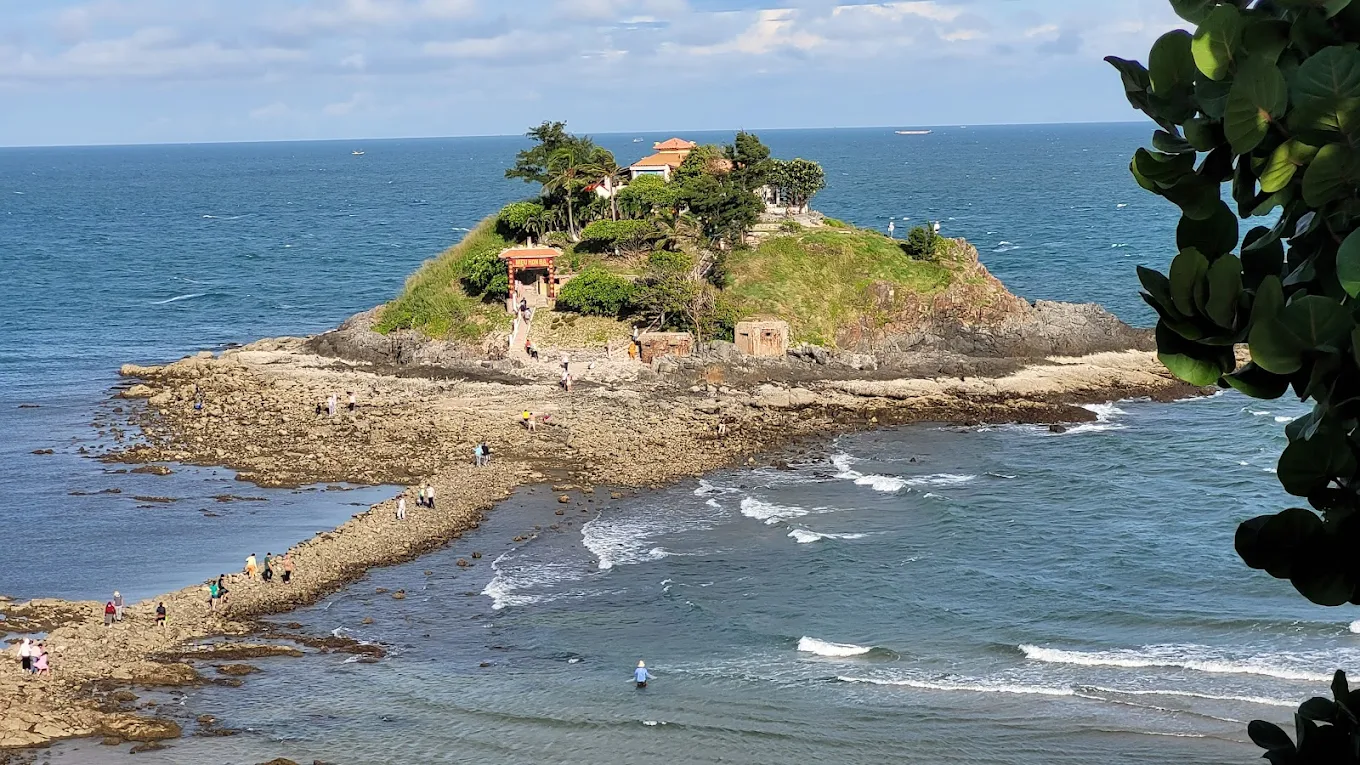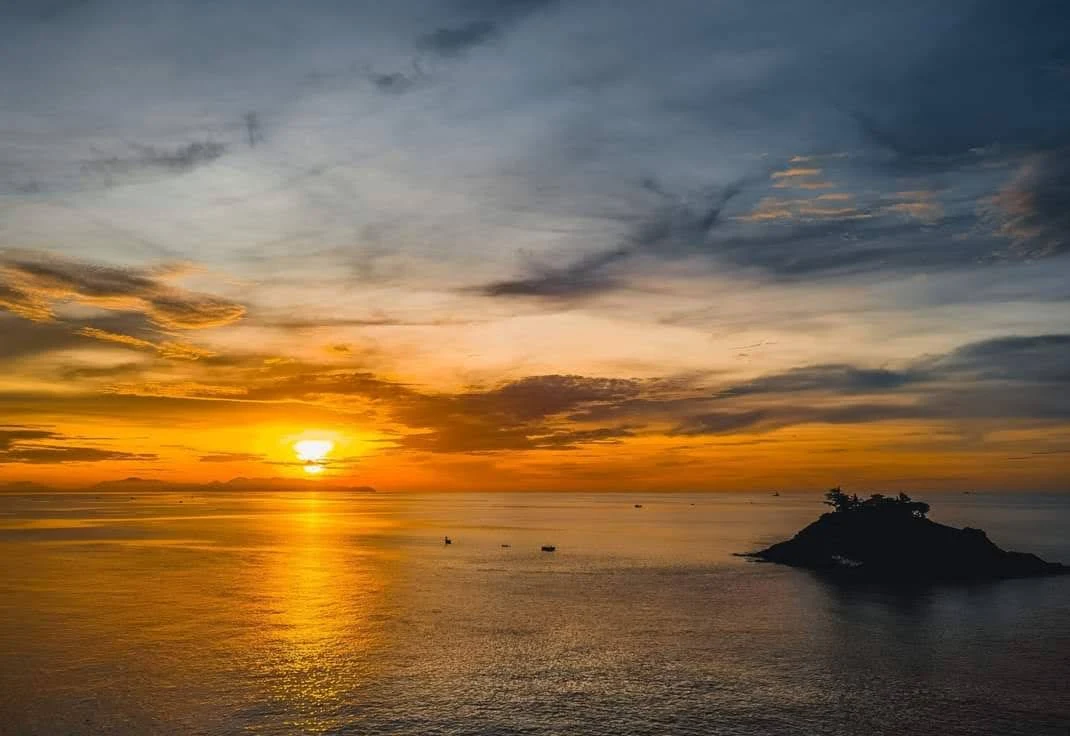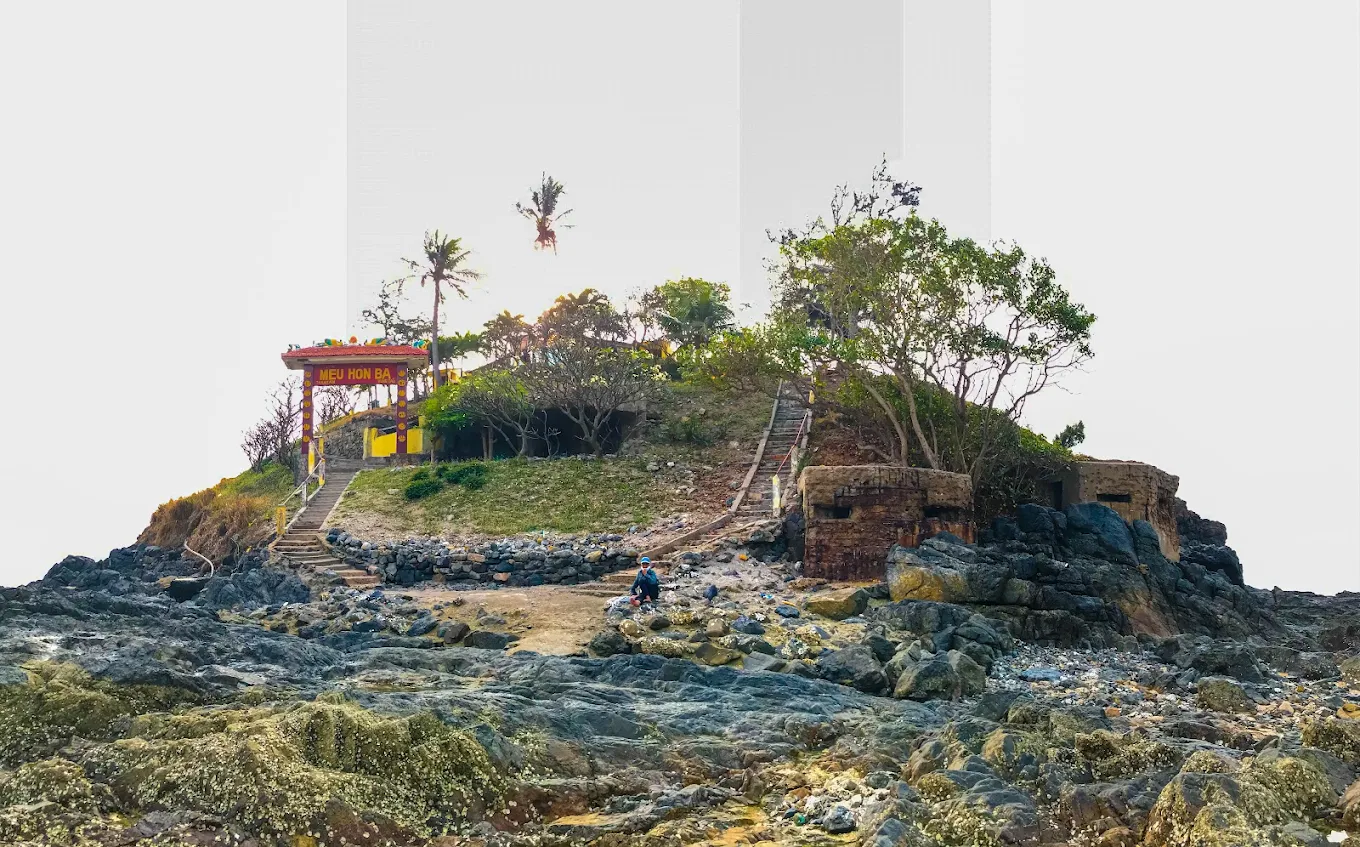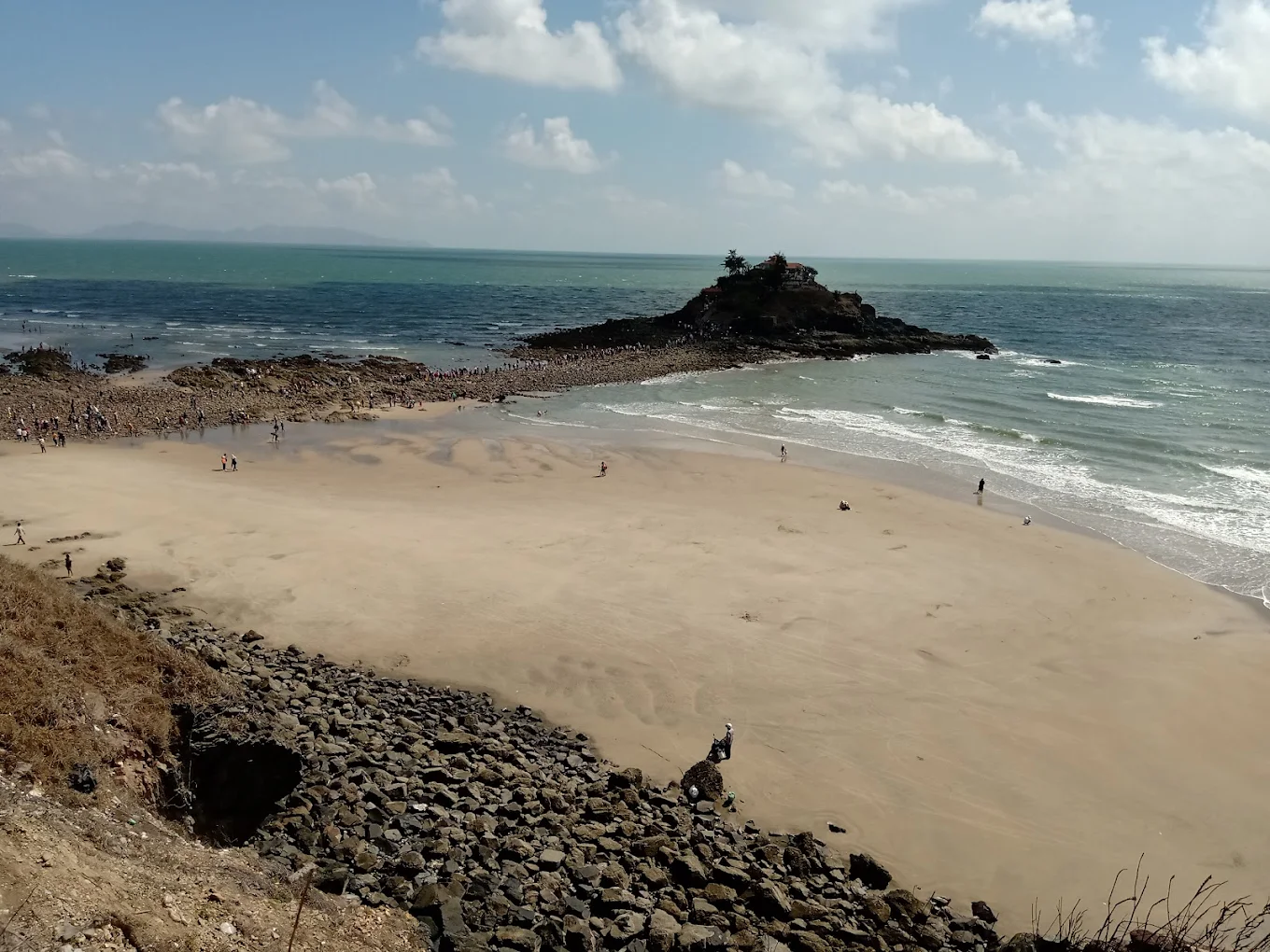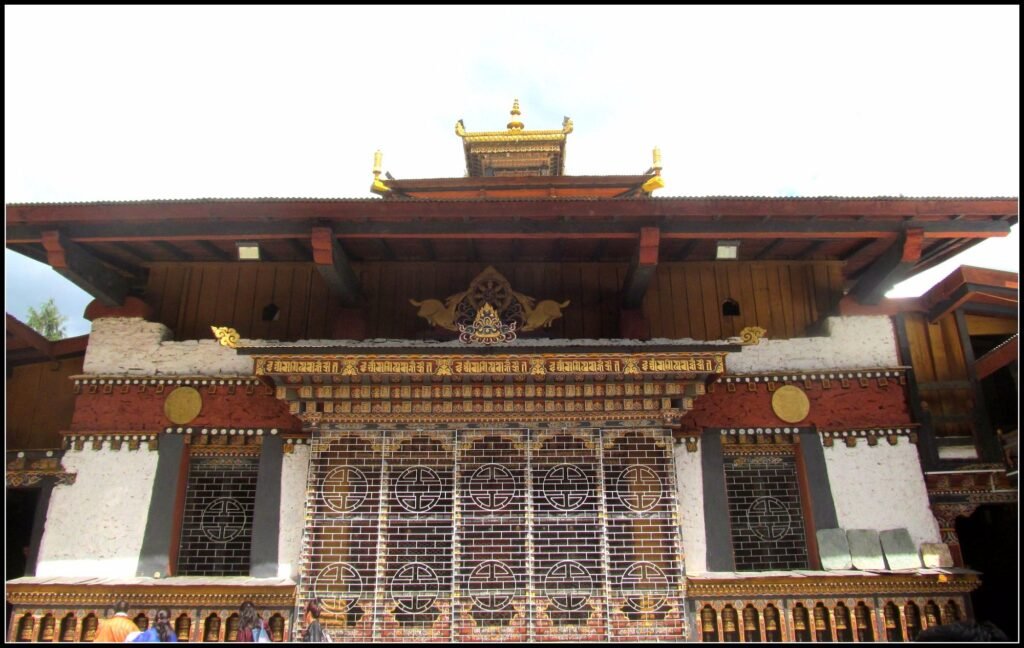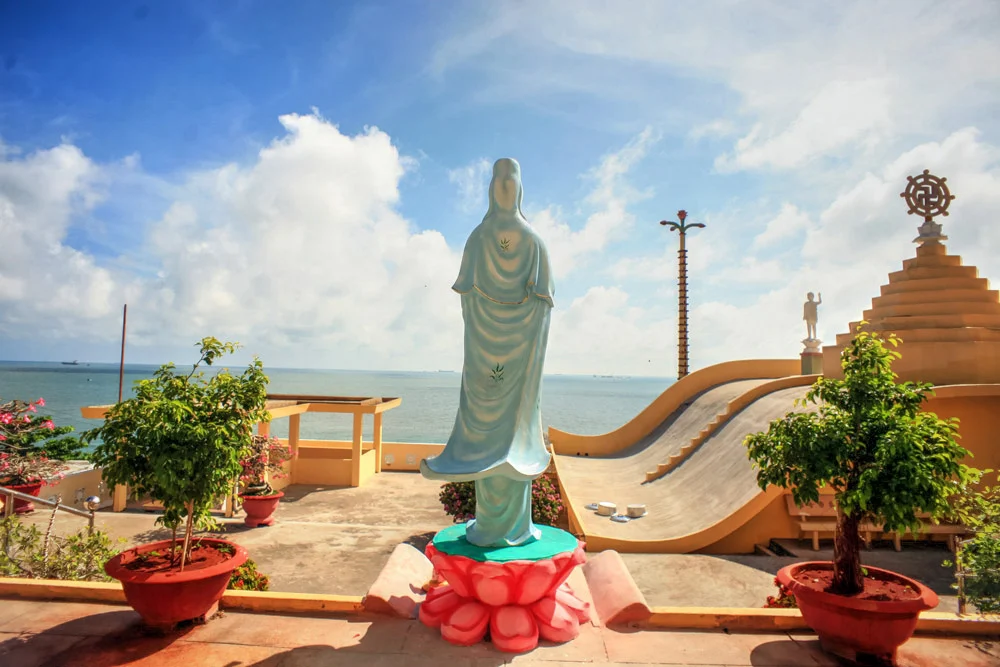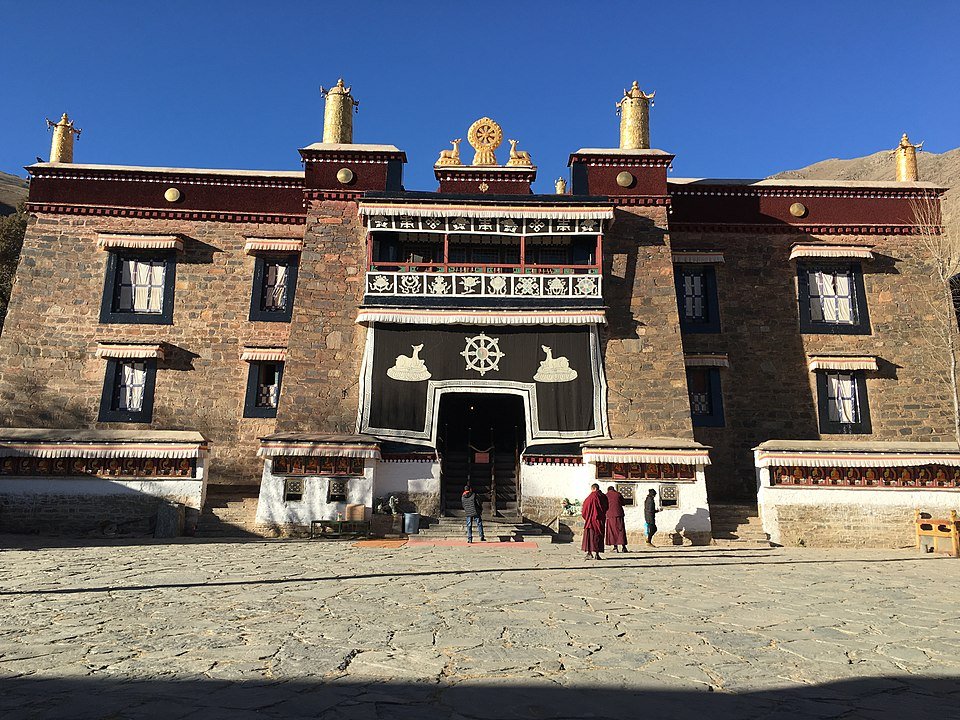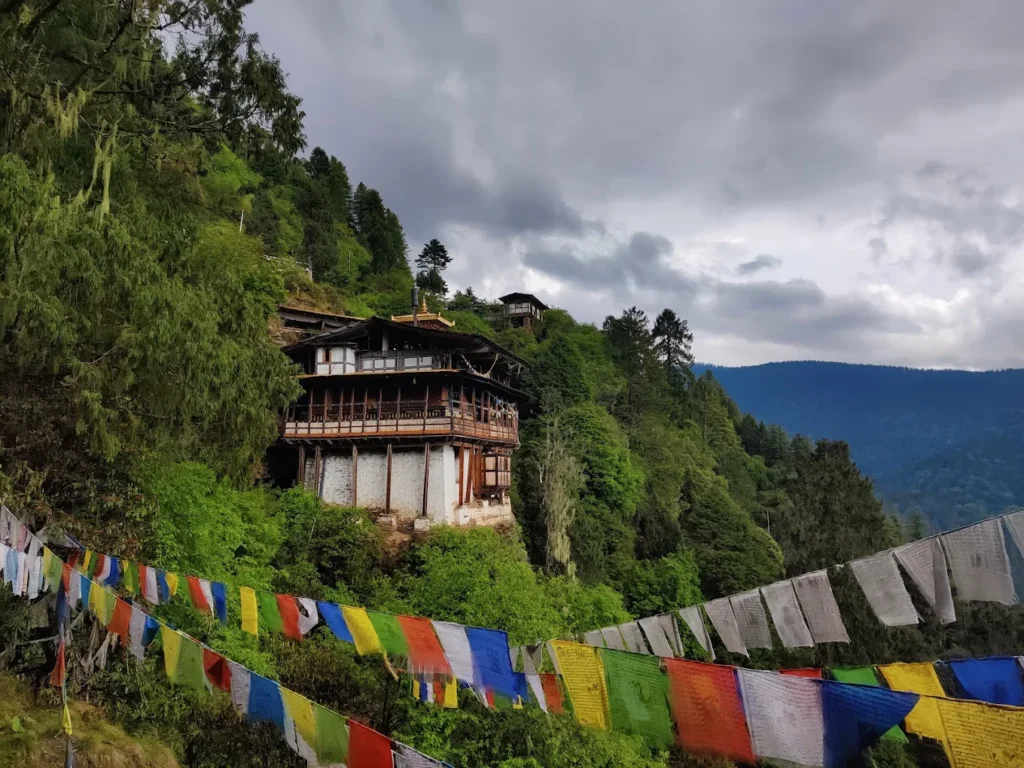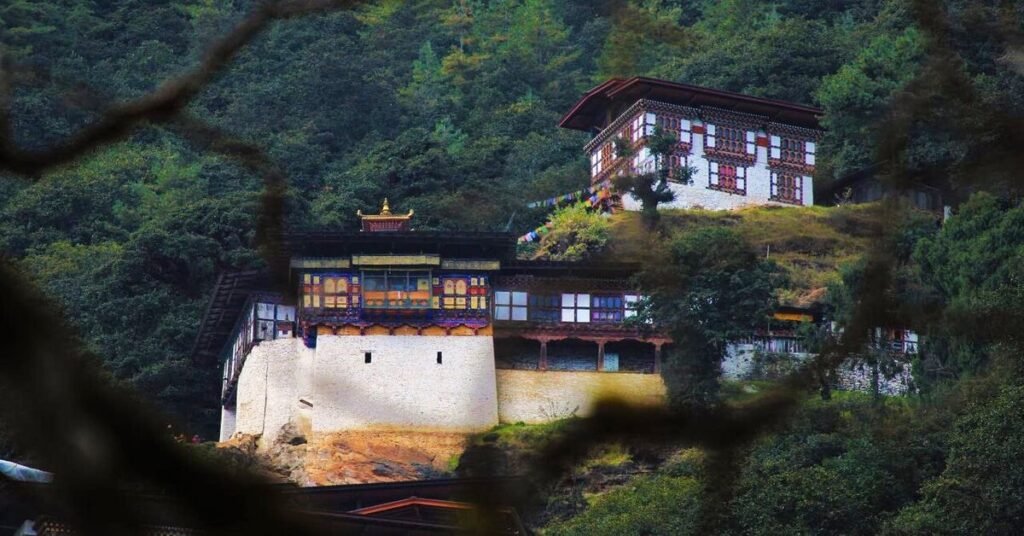Ngũ Hành Miếu Pagoda: The Sacred Island Sanctuary of Vũng Tàu’s Maritime Spirit
At dawn, as the tide recedes from Hòn Bà, a tiny island off Vũng Tàu’s Bãi Sau, a stone path emerges from the sea, leading to Ngũ Hành Miếu Pagoda. In the main hall (chánh điện), fishermen offer sandalwood incense before the vibrant statues of Ngũ Hành Nương Nương, the Five Elements Goddesses, their colorful robes—white, green, black, red, yellow—gleaming under flickering lamps. Founded in 1832, this modest shrine, perched 4 meters above the island’s rocky crest, pulses with the prayers of Vũng Tàu’s fishing community, seeking protection from the sea’s caprice. The rhythmic crash of waves blends with the chant of ancient rites, tying the pagoda to the ocean’s heartbeat. Each lotus flower placed at the goddesses’ feet honors their guardianship over Kim, Mộc, Thủy, Hỏa, and Thổ. From this sacred islet, Vũng Tàu’s coastline stretches wide, a testament to resilience and faith. This spiritual haven invites travelers, seekers, and scholars to tread its tidal path and connect with Vietnam’s maritime soul.
Whispers of the Sea: Overview and Significance
Introduction to Ngũ Hành Miếu Pagoda
Ngũ Hành Miếu Pagoda, perched on Hòn Bà island off Vũng Tàu’s Bãi Sau, is a revered shrine of Vietnamese folk belief, dedicated to Ngũ Hành Nương Nương, the Five Elements Goddesses who govern Kim (metal), Mộc (wood), Thủy (water), Hỏa (fire), and Thổ (earth). Accessible only by a stone path revealed at low tide, this compact sanctuary embodies the spiritual pulse of Vũng Tàu’s fishing community, offering protection and prosperity to seafarers. Its vibrant architecture and maritime rituals draw pilgrims and explorers seeking to experience Vietnam’s coastal faith. A cultural gem, the pagoda blends ancient beliefs with the rhythm of the sea, its island setting a beacon of divine harmony.
Historical Journey
Ngũ Hành Miếu Pagoda was established in 1832 during the Nguyễn Dynasty, born from the fishing community’s need for divine protection against stormy seas. In 1845–1846, Emperor Thiệu Trị granted four imperial decrees honoring Thiên Y A Na Diễn Ngọc Phi, a goddess linked to the Five Elements, elevating the shrine’s status. Emperor Tự Đức followed in 1850 with two decrees for Thiên Y A Na and Thủy Long Thần Nữ, reinforcing its sacred role. Rebuilt in the 1970s after wartime damage, the pagoda remains a vital spiritual anchor, its history intertwined with Vũng Tàu’s maritime heritage.
Cultural Significance
- Folk Belief Foundation: Rooted in Vietnamese folk religion, the pagoda venerates the Five Elements Goddesses, believed to balance nature and protect livelihoods.
- Ethnic Vietnamese Heritage: A spiritual cornerstone for the Kinh community, it preserves maritime rituals like sea blessings and goddess offerings.
- Maritime Connection: Its island location ties it to fishermen’s prayers for safe voyages and bountiful catches.
- Regional Influence: Annual festivals draw devotees from Bà Rịa-Vũng Tàu and beyond, uniting coastal communities.
Unique Legacy
- Island Sanctuary: The pagoda’s Hòn Bà setting, accessible only at low tide, symbolizes divine connection to the sea.
- Ngũ Hành Worship: The vibrant statues of the Five Elements Goddesses embody cosmic balance, unique to coastal folk beliefs.
- Community Resilience: Built by fishermen’s collective efforts, it reflects grassroots devotion.
- Maritime Symbol: Its rituals and location make it a beacon of Vũng Tàu’s seafaring culture.
Community and Global Impact
- Local Devotion: The pagoda hosts vibrant festivals, strengthening Kinh fishing community bonds.
- Pilgrimage Hub: Thousands visit annually, drawn by its spiritual and historical allure.
- Global Appeal: International travelers seek its unique tidal path and maritime rituals.
- Cultural Dialogue: Shared ceremonies unite locals and visitors, fostering cross-cultural understanding.
Modern Relevance
- Spiritual Haven: Amid modern stresses, the pagoda offers solace for those seeking peace.
- Cultural Preservation: It safeguards folk rituals, ensuring Vũng Tàu’s maritime heritage thrives.
- Eco-Spiritual Harmony: Its island setting promotes reverence for the ocean’s rhythms.
Historical Anecdotes
- Nguyễn Dynasty Decrees: Imperial recognition in the 1840s elevated the pagoda’s sanctity, tying it to royal faith.
- War-Time Refuge: During conflicts, fishermen hid in Hòn Bà’s tunnels, praying for safety.
- Community Rebuild: The 1970s reconstruction, led by locals, restored its spiritual role.
Social Role
- Community Hub: Festivals and rituals unite Vũng Tàu’s fishing families.
- Educational Center: Elders share maritime folklore, preserving cultural knowledge.
- Charitable Spirit: Communal offerings reflect folk belief’s generosity.
Artistic Influence
- Ritual Art: Festival decorations, like lotus lanterns, inspire local craftsmanship.
- Cultural Icon: The pagoda’s island silhouette graces Vũng Tàu’s art and literature.
- Symbolic Motifs: Goddess statues’ vibrant colors inspire coastal aesthetics.
From its humble origins as a fishermen’s shrine, Ngũ Hành Miếu Pagoda has grown into a spiritual and cultural cornerstone, its island perch a testament to Vũng Tàu’s maritime soul. The Five Elements Goddesses, enshrined in vibrant hues, embody the balance of nature and human endeavor, their presence woven into the daily lives of seafarers. This sacred space, accessible only when the sea permits, bridges the earthly and divine, inviting exploration of its physical and spiritual dimensions. As we delve into its architecture, the pagoda’s design reveals how its modest form amplifies its profound connection to the ocean and its deities.
Crafted by the Waves: Architectural and Spiritual Features
Iconic Design
Ngũ Hành Miếu Pagoda’s architecture blends Vietnamese folk simplicity with its dramatic island setting, creating a sanctuary that feels both humble and sacred. Perched 4 meters above Hòn Bà’s rocky crest, its red-tiled roof and whitewashed walls, adorned with “Lưỡng long chầu nguyệt” (twin dragons facing the moon) motifs, harmonize with the surrounding waves. The compact layout, centered on the main hall, prioritizes functionality for maritime rituals, with open spaces for offerings. Its tidal accessibility, revealed only at low tide, underscores its mystical bond with the sea.
Key Structures
- Main Hall (Chánh Điện): The spiritual core, housing the Ngũ Hành Nương Nương statues, features wooden beams and dragon carvings.
- Courtyard: A small, stone-paved space with incense burners, used for communal rites.
- Entrance Path: A tidal stone path, emerging at low tide, connects the island to Bãi Sau.
- Side Altars: Smaller shrines for Quan Công, Quan Bình, and Châu Xương, protecting seafarers.
- Underground Tunnel: A 6-meter-long historical chamber, once a revolutionary hideout.
Worshipped Statues
- Ngũ Hành Nương Nương: Five statues, each in distinct robes—Kim (white), Mộc (green), Thủy (black), Hỏa (red), Thổ (yellow)—represent the Five Elements, balancing nature’s forces.
- Thiên Y A Na and Thủy Long Thần Nữ: Central statues, adorned with imperial sashes, symbolize divine protection.
- Quan Công Triad: Bronze statues of Quan Công, Quan Bình, and Châu Xương, revered for maritime safety.
- Spiritual Role: Devotees offer incense to the goddesses, seeking harmony and safe voyages.
Materials and Techniques
- Construction: Local stone and wood, assembled with traditional Vietnamese joinery, withstand coastal elements.
- Artistry: Dragon carvings and ceramic tiles, crafted by Kinh artisans, reflect folk symbolism.
- Cultural Essence: The design prioritizes maritime functionality, distinct from ornate Buddhist styles.
Signature Elements
- Tidal Path: The stone path, revealed at low tide, symbolizes divine accessibility.
- Dragon Roof: The “Lưỡng long chầu nguyệt” motif signifies protection and cosmic harmony.
- Goddess Altars: The colorful statues anchor the pagoda’s spiritual mission.
Lesser-Known Features
- Historical Inscriptions: Stone tablets bear 19th-century prayers from fishermen.
- Hidden Tunnel: A wartime chamber beneath the pagoda, used for secret meetings.
- Ancient Anchor: A weathered anchor near the entrance, symbolizing maritime heritage.
Preservation Efforts
- Restoration (1970s): Rebuilt post-war with community effort, preserving original design.
- Challenges: Sea erosion threatens foundations, requiring regular maintenance.
- Modern Additions: Solar lanterns, added recently, light the tidal path.
Environmental Integration
- Island Harmony: The pagoda’s design respects Hòn Bà’s rocky ecosystem.
- Eco-Practices: Fishermen maintain the island’s cleanliness, honoring the sea.
- Wildlife Haven: Seabirds nest nearby, enhancing spiritual ambiance.
Artisan Narratives
- Roof Carvers: Vũng Tàu artisans crafted the dragon motifs, blending folk art with maritime themes.
- Statue Makers: Local sculptors painted the goddesses’ robes, reflecting elemental symbolism.
- Path Builders: Fishermen laid the tidal path, a labor of devotion.
Symbolic Details
- Five Colors: The goddesses’ robes symbolize cosmic balance.
- Dragon Motifs: Represent divine protection over the sea.
- Lotus Offerings: Symbolize purity amid turbulent waters.
Landscape Integration
- Island Setting: Hòn Bà’s isolation enhances spiritual focus.
- Sea Views: The pagoda frames Vũng Tàu’s coastline, tying faith to the ocean.
- Tidal Rhythm: The path’s emergence mirrors the sea’s divine timing.
The vibrant statues and tidal path of Ngũ Hành Miếu Pagoda are more than architectural features; they are conduits for the spiritual practices that define its maritime soul. The Five Elements Goddesses, enshrined in their colorful robes, guide fishermen through rituals that honor the sea’s rhythms. These practices, rooted in centuries of coastal faith, bring the pagoda to life, inviting visitors to engage with its sacred traditions. As we explore its rituals, the pagoda reveals how its spiritual life pulses in harmony with the tides.
Rites of the Tides: Rituals and Practices
Daily Sacred Rites
- Morning Offerings: Fishermen light incense before the Ngũ Hành Nương Nương statues, praying for safe voyages.
- Chanting: Elders recite folk prayers at dawn, invoking elemental balance.
- Sea Blessings: Offerings of flowers are cast into the sea, honoring Thủy Long Thần Nữ.
Unique Practices
- Tidal Offerings: Devotees place miniature boats on altars during low tide, a coastal rite for maritime safety.
- Five Elements Ritual: Offerings of five distinct items (e.g., metal coins, wooden carvings) honor each goddess.
- Signature Ritual: Lighting five-colored candles, tied to the pagoda’s elemental worship, fosters harmony.
Festival Traditions
- Ngũ Hành Festival (16–18th, 10th lunar month): A vibrant procession with dragon dances and lotus offerings draws thousands.
- Lunar Ceremonies (1st, 15th lunar days): Fishermen offer fruits and chants for prosperity.
- Seasonal Rites (January, April, July, October): Ceremonies honor Thủy Long Thần Nữ, with statue adornments.
- Statue Veneration: Goddesses’ statues are draped in silk during festivals, symbolizing reverence.
Visitor Engagement
- Accessible Rituals: Visitors can light incense or join sea blessings, guided by elders.
- Offerings: Flowers and candles, available at the pagoda, invite participation.
- Folk Etiquette: Bow three times before statues, signaling respect.
Spiritual Community Roles
- Elders: Local fishermen lead rituals, preserving maritime traditions.
- Devotees: Kinh volunteers organize festivals, maintaining the pagoda.
- Statue Care: Daily cleaning of statues reflects devotion.
Interfaith Connections
- Syncretic Practices: Some blend folk prayers with Buddhist chants, offering fruit to local deities.
- Outreach: Festivals welcome diverse faiths, fostering unity.
- Education: Elders share folklore with visitors, deepening understanding.
Ritual Symbolism
- Five Colors: Candles and robes symbolize elemental balance.
- Sea Offerings: Flowers cast into waves represent trust in divine protection.
- Dragon Dances: Evoke cosmic harmony during festivals.
Seasonal Variations
- Spring Rites: Vibrant with lotuses, ideal for Ngũ Hành Festival.
- Monsoon Season: Chants under rain connect to Thủy goddess.
- Autumn Ceremonies: Clear skies enhance sea blessings.
Monastic Life
- Caretaker Role: Lay elders, not monks, manage rituals, reflecting folk belief traditions.
- Community Service: Elders guide visitors in offerings, fostering connection.
- Ritual Training: Young fishermen learn chants, preserving heritage.
The rituals of Ngũ Hành Miếu Pagoda, pulsing with the sea’s rhythms, invite visitors to step into a living tradition of maritime faith. From the tidal path to the vibrant goddess statues, the pagoda’s spiritual practices create a bridge between devotees and the divine. For travelers, these rites offer a chance to engage with Vũng Tàu’s coastal culture, accessible only when the tides align. As we turn to visitor information, the pagoda’s unique island setting guides practical planning, ensuring a meaningful journey to this sacred space.
Journey to the Island: Visitor Information
Navigating to Ngũ Hành Miêu Pagoda
- Location: Hòn Bà island, off Thùy Vân Street, Bãi Sau, Phường Thắng Tam, Vũng Tàu City, Bà Rịa-Vũng Tàu Province, 200 meters from shore.
- Landmarks: Near the Statue of Christ the King and Dốc Con Rồng, with signs in Vietnamese and English.
- Routes: Walk from Bãi Sau during low tide, or take a boat during high tide.
Address of Ngũ Hành Miếu Pagoda
- Vietnamese: Ngũ Hành Miếu, Đảo Hòn Bà, Đường Thùy Vân, Phường Thắng Tam, Thành phố Vũng Tàu, Tỉnh Bà Rịa-Vũng Tàu.
- English: Ngũ Hành Miếu Pagoda, Hòn Bà Island, Thùy Vân Street, Thắng Tam Ward, Vũng Tàu City, Bà Rịa-Vũng Tàu Province.
Visiting Hours and Etiquette
- Hours: Open daily, 6:00 AM–5:00 PM, with extended festival hours.
- Etiquette: Dress modestly, remove shoes before the main hall, and avoid loud speech.
- Folk Custom: Offer incense with both hands and bow to the goddesses.
Transport Options
- By Foot: Walk the tidal path from Bãi Sau during low tide (14th–15th lunar days, around 5:00 PM).
- By Boat: Small boats from Bãi Sau access the island during high tide.
- By Motorbike: Ride to Bãi Sau, then walk to the path or boat dock.
Accessibility and Safety
- Mobility: The rocky tidal path may challenge those with mobility issues; no ramps available.
- Safety: Stable path during low tide, with local guides ensuring safety.
- Tips: Wear sturdy shoes for the rocky path and check tide schedules.
Amenities and Surroundings
- Facilities: A small shop offers incense, flowers, and candles; no restrooms on the island.
- Nearby: Bãi Sau Beach and Đình Thắng Tam, within 1 km, offer cultural experiences.
- Dining: Vegetarian stalls near Bãi Sau serve mindful meals.
Immersive Visitor Tips
- Best Timing: Visit at low tide (14th–15th lunar days) for the tidal path experience.
- Sensory Moments: Feel the sea breeze and hear waves during offerings.
- Statue Connection: Offer candles to the goddesses and reflect briefly.
- Festival Planning: Attend the Ngũ Hành Festival (16–18th, 10th lunar month) for processions.
Nearby Cultural Experiences
- Đình Thắng Tam: Explore this historic shrine, 1 km away, part of the Ngũ Hành festival route.
- Bãi Sau Beach: Enjoy Vũng Tàu’s vibrant coast, steps from the tidal path.
- Statue of Christ the King: A nearby landmark with panoramic views.
Photography Tips
- Best Angles: Capture the tidal path at dusk for dramatic light.
- Respectful Shots: Avoid photographing rituals without permission.
- Scenic Views: The island offers stunning coastal shots.
- Equipment: A smartphone suffices for the compact site.
The journey to Ngũ Hành Miếu Pagoda, guided by the tides, is both a physical and spiritual pilgrimage, inviting visitors to engage with its maritime rituals. The pagoda’s island setting and vibrant goddess worship offer a window into Vũng Tàu’s coastal faith, where the sea and divine converge. Beyond its physical beauty, the pagoda’s deeper cultural and spiritual significance enriches the experience, revealing the heart of Vietnam’s folk traditions. As we explore these insights, the pagoda’s role as a cultural and spiritual beacon comes into sharper focus, deepening our connection to its sacred legacy.
Cultural and Spiritual Insights
Folk Belief Philosophy
Ngũ Hành Miếu Pagoda embodies Vietnamese folk belief in the Five Elements, where Kim, Mộc, Thủy, Hỏa, and Thổ govern nature’s balance, protecting livelihoods. The goddesses inspire harmony, guiding fishermen through life’s uncertainties. This philosophy, rooted in cosmic equilibrium, encourages reverence for the natural world.
Maritime Spirituality
The pagoda’s Hòn Bà setting ties it to Vũng Tàu’s fishing culture, with rituals honoring the sea’s rhythms. Offerings of boats and flowers reflect trust in the goddesses’ protection. The tidal path symbolizes divine accessibility, open only when nature permits.
Artistic Symbolism
The goddesses’ colorful robes—white, green, black, red, yellow—symbolize elemental balance. Dragon motifs evoke cosmic protection, while lotus offerings signify purity. These elements weave maritime faith into the pagoda’s aesthetic.
Community Resilience
Built by fishermen, the pagoda reflects Kinh perseverance, sustained through communal rituals. Its post-war rebuild showcases collective faith, uniting Vũng Tàu’s coastal community.
Environmental Stewardship
The pagoda’s island setting fosters respect for the ocean. Fishermen maintain Hòn Bà’s cleanliness, aligning with folk belief’s environmental harmony. Visitors are urged to honor the sea’s sanctity.
Meditative Practices
Folk meditation involves quiet prayers before the goddesses, seeking balance. The main hall’s calm, with sea sounds, enhances reflection, accessible to all visitors.
Cultural Narratives
- Goddess Legends: Tales of Ngũ Hành Nương Nương saving fishermen fuel devotion.
- Festival Stories: Elders share tales of processions, linking past and present.
- Maritime Lore: Stories of safe voyages tied to the pagoda’s blessings.
Historical Context
- Nguyễn Dynasty: Imperial decrees elevated the pagoda’s status.
- War-Time Role: Hòn Bà’s tunnel served as a revolutionary hideout.
- Cultural Continuity: Festivals preserve Vũng Tàu’s maritime traditions.
Reflecting on the Journey
Ngũ Hành Miếu Pagoda, perched on Hòn Bà’s rocky crest, is a sanctuary where the sea meets the divine. The Five Elements Goddesses, enshrined in vibrant robes, embody the balance that guides Vũng Tàu’s fishermen, their prayers carried by the tides. The tidal path, revealed only at nature’s whim, tells a story of faith, resilience, and unity, rooted in Vietnam’s folk traditions. Whether offering incense to the goddesses, walking the sea-swept path, or tracing Vũng Tàu’s maritime heritage, visitors find a space to reflect and connect. As you depart, the echo of waves and scent of incense linger, a reminder that harmony is always within reach.
